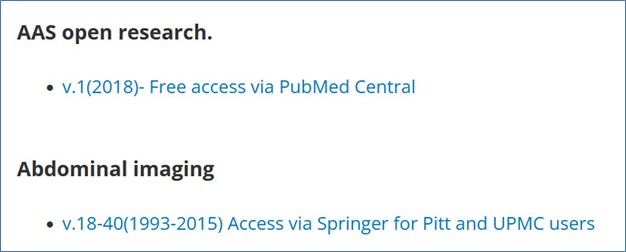Learn the most effective way to include links to resources in your syllabus, presentation, Canvas site, or other course content. This article will also cover forming and sharing durable library URLs, ensuring that students can access materials on campus or at home.
Durable URLs
A “durable” URL, sometimes referred to as a permalink or permanent URL, is a direct, stable link to a specific resource or document. Using a durable URL ensures proper access.
An example of a durable URL is https://link.springer.com/book/10.1007/978-1-0716-2441-8
In contrast, this is not a durable URL, because the results that show via Google may change over time: https://www.google.com/search?q=Gene+Therapy+of+Cancer+Methods+and+Protocols&rlz=1C1GCEA_enUS909US910&oq=Gene+Therapy+of+Cancer+Methods+and+Protocols&aqs=chrome..69i57.607j0j4&sourceid=chrome&ie=UTF-8
A DOI may also be used in place of a URL, if HSLS subscribes to the resource, for example https://doi.org/10.1007/978-1-0716-2441-8
Copy Links from PittCat
The newest version of PittCat allows you to link right to a citation in the Pitt catalog, where you can find full-text links. Click on the permalink icon in the “Send To” options and copy the permalink to the clipboard.
Copy Links from HSLS Resource Pages
If you are linking to a database, journal, or e-book, you can copy the correctly formatted URL directly from the HSLS website’s resource pages. Right-click or long-press on a link and select “Copy link address” or “Copy.”
Free vs. Paid Access
Some resources are freely available to the public and some require Pitt Passport authentication when accessing them remotely because they are subscription-based. How can you tell the difference between these resources?
On the HSLS website, you will see an access note in the link. For instance, when comparing two journals, we can see that AAS Open Research is free, because it is noted as having “Free access.” Contrastingly, Abdominal Imaging is subscription-based, indicated by the note that access is provided for only Pitt and UPMC users.
Access notes are also evident in PittCat. For the journal Nature, access is subscription-based and is provided for only Pitt and UPMC users.


Paid Access EZproxy
Links for subscription-based resources need to have an EZproxy URL (https://pitt.idm.oclc.org/login?url=) added as a prefix. This routes users through a proxy server (again, by logging in to Pitt Passport) so that they are recognized as a University of Pittsburgh user when trying to access a resource remotely.
For example, the following links utilize the EZproxy URL prefix to take users to the “Gene Therapy of Cancer: Methods and Protocols” e-book. The first link uses a URL, and the second utilizes a DOI:
https://pitt.idm.oclc.org/login?url=https://link.springer.com/book/10.1007/978-1-0716-2441-8
https://pitt.idm.oclc.org/login?url=https://doi.org/10.1007/978-1-0716-2441-8
Note: Free resources do not need to have the EZproxy prefix added and may not work if added. Also, links that are found on the HSLS website for subscription-based resources already include the EZproxy prefix.
Test the Links
When you have added URLs to course materials, be sure to test the links. It often helps to test your links off-campus, in another browser where you have not previously logged in to Pitt Passport, in order to replicate the student experience.
Support
If you have any questions or difficulty linking to an HSLS resource, please contact HSLS Ask a Librarian.
~Ann Passmore